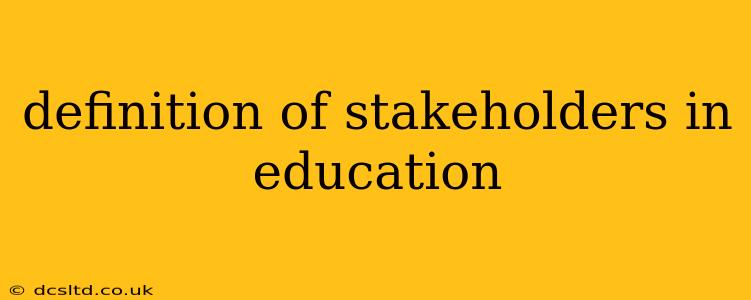Defining Stakeholders in Education: A Comprehensive Guide
The term "stakeholders in education" encompasses a broad range of individuals and groups who have a vested interest in the success and well-being of educational institutions and their students. Understanding who these stakeholders are and their diverse perspectives is crucial for effective educational policy and practice. This article will delve into a precise definition, explore the different categories of stakeholders, and address frequently asked questions.
What are stakeholders in education?
Stakeholders in education are individuals or groups who are impacted by or can influence the educational system. Their interests may be direct (e.g., students, teachers) or indirect (e.g., community members, policymakers). They all share a common goal: to improve the quality of education and foster student success. However, their specific interests and priorities can often differ, leading to complex dynamics within the educational landscape.
Who are the key stakeholders in education?
While the specific stakeholders can vary depending on the level of education (primary, secondary, higher education), some key groups consistently emerge:
1. Students:
These are the primary beneficiaries of the education system. Their needs, learning styles, and well-being are central to any successful educational endeavor. Understanding student perspectives is vital for creating engaging and effective learning environments.
2. Teachers & Educators:
Teachers are the front-line implementers of educational policy and curriculum. Their expertise, dedication, and professional development are essential for high-quality teaching and student achievement.
3. Parents & Families:
Parents and families play a significant role in a child's educational journey. Their support, involvement, and communication with schools are crucial for student success. They often act as advocates for their children's needs.
4. School Administrators & Staff:
Principals, superintendents, and other administrative staff oversee the day-to-day operations of schools. They are responsible for resource allocation, policy implementation, and ensuring a supportive school environment. Support staff, such as counselors, librarians, and secretaries, also play crucial roles.
5. School Boards & Governing Bodies:
These bodies are responsible for overseeing the educational system at a local or regional level. They set policies, allocate resources, and ensure accountability.
6. Government & Policy Makers:
At the local, state, and national levels, government agencies and policymakers shape educational policy, funding, and regulations. Their decisions have a profound impact on the entire education system.
7. Community Members & Organizations:
Local businesses, community groups, and non-profit organizations can contribute significantly to schools through volunteering, fundraising, and providing resources. They represent the broader societal context within which schools operate.
8. Higher Education Institutions:
Universities and colleges are key stakeholders, especially in relation to secondary education. They influence curriculum standards, teacher training, and provide pathways for students' further learning.
9. Businesses & Employers:
Businesses and employers are increasingly recognized as stakeholders due to their role in providing work-based learning opportunities, shaping curriculum relevant to industry needs, and employing graduates.
Frequently Asked Questions about Stakeholders in Education
What are the different interests of stakeholders in education?
The interests of stakeholders can be diverse and sometimes conflicting. Students might prioritize enjoyable learning experiences and relevant curriculum, while teachers might focus on resources, professional development, and manageable workloads. Parents may prioritize their children's academic success and safety, while administrators focus on budget constraints and school performance metrics. Policymakers may concentrate on broader societal goals, such as improving national test scores or equity in education.
How can stakeholder involvement improve education?
Effective stakeholder engagement can lead to a more responsive and effective education system. By actively involving all stakeholders in decision-making processes, schools can create a shared vision, build trust, and ensure that the educational system meets the needs of all involved. This collaborative approach can lead to improved student outcomes, enhanced teacher morale, and stronger community support for education.
How can conflicts between stakeholders be resolved?
Conflicts between stakeholders are inevitable, given the diverse interests involved. Effective communication, compromise, and open dialogue are essential for resolving these conflicts. Mediation and collaborative problem-solving strategies can help stakeholders find common ground and work towards shared goals.
In conclusion, understanding the diverse roles and interests of stakeholders in education is paramount for creating a successful and equitable educational system. By fostering collaboration, communication, and a shared commitment to student success, we can build stronger and more effective schools that benefit all stakeholders.
